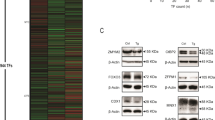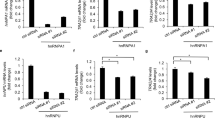Abstract
Background
Transformer (Tra) 2β is a member of the serine/arginine-rich (SR)-like protein family that regulates alternative splicing of numerous genes in a concentration-dependent manner. Several types of cancer cells up-regulate Tra2β expression, while the regulatory mechanism of Tra2β expression remains to be elucidated. In this study, we examined the transcriptional regulation and possible functions of Tra2β in human colon cancer cells.
Methods
We cloned 959 bp-upstream of the human TRA2β 5′-flank into luciferase constructs. Chromatin immunoprecipitation (ChIP) was employed to identify crucial cis element(s) and trans activator(s) of the TRA2β promoter. Tra2β expression in the human colon and colon cancer tissues was examined by immunohistochemistry.
Results
In response to sodium arsenite, colon cancer cells (HCT116) increased levels of TRA2β1 mRNA encoding a functional, full-length Tra2β with a peak around 6 h without changing its mRNA stability. Transient expression assays using a reporter gene driven by serially truncated TRA2β promoters and Chip assay demonstrated that an Ets1-binding site present at −64 to −55 bp was crucial for basal transcription, while three heat shock elements (HSEs) located at −145 to −99 bp mediated the oxidant-induced transactivation of TRA2β. Tra2β knockdown caused apoptosis of HCT116 cells. Tra2β were preferentially expressed in proliferative compartment of normal human colonic glands and adenocarcinomas, where Ets1 and heat shock factor 1 were also highly expressed.
Conclusions
Our results suggest that oxidative stress-responsive Tra2β may play an important role in colon cancer growth.







Similar content being viewed by others
References
Matsuo N, Ogawa S, Imai Y, et al. Cloning of a novel RNA binding polypeptide (RA301) induced by hypoxia/reoxygenation. J Biol Chem. 1995;270:28216–22.
Beil B, Screaton G, Stamm S. Molecular cloning of htra2-beta-1 and htra2-beta-2, two human homologs of tra-2 generated by alternative splicing. DNA Cell Biol. 1997;16:679–90.
Tacke R, Tohyama M, Ogawa S, et al. Human Tra2 proteins are sequence-specific activators of pre-mRNA splicing. Cell. 1998;93:139–48.
Hertel KJ, Maniatis T. The function of multisite splicing enhancers. Mol Cell. 1998;1:449–55.
Qi J, Su S, McGuffin ME, et al. Concentration dependent selection of targets by an SR splicing regulator results in tissue-specific RNA processing. Nucleic Acids Res. 2006;34:6256–63.
Nayler O, Cap C, Stamm S. Human transformer-2-beta gene (SFRS10): complete nucleotide sequence, chromosomal localization, and generation of a tissue-specific isoform. Genomics. 1998;53:191–202.
Hofmann Y, Lorson CL, Stamm S, et al. Htra2-beta 1 stimulates an exonic splicing enhancer and can restore full-length SMN expression to survival motor neuron 2 (SMN2). Proc Natl Acad Sci USA. 2000;97:9618–23.
Singh NN, Androphy EJ, Singh RN. In vivo selection reveals combinatorial controls that define a critical exon in the spinal muscular atrophy genes. RNA. 2004;10:1291–305.
Martins de Araujo M, Bonnal S, Hastings ML, et al. Differential 3′ splice site recognition of SMN1 and SMN2 transcripts by U2AF and U2 snRNP. RNA 2009;15:515–23.
Jiang Z, Tang H, Havlioglu N, et al. Mutations in tau gene exon 10 associated with FTDP-17 alter the activity of an exonic splicing enhancer to interact with Tra2 beta. J Biol Chem. 2003;278:18997–9007.
Kondo S, Yamamoto N, Murakami T, et al. Tra2 beta, SF2/ASF and SRp30c modulate the function of an exonic splicing enhancer in exon 10 of tau pre-mRNA. Genes Cells. 2004;9:121–30.
Watermann DO, Tang Y, Zur Hausen A, et al. Splicing factor Tra2-beta1 is specifically induced in breast cancer and regulates alternative splicing of the CD44 gene. Cancer Res. 2006;66:4774–80.
Tsukamoto Y, Matsuo N, Ozawa K, et al. Expression of a novel RNA-splicing factor, RA301/Tra2beta, in vascular lesions and its role in smooth muscle cell proliferation. Am J Pathol. 2001;158:1685–94.
Kiryu-Seo S, Matsuo N, Wanaka A, et al. A sequence-specific splicing activator, tra2beta, is up-regulated in response to nerve injury. Brain Res Mol Brain Res. 1998;62:220–3.
Gabriel B, Zur Hausen A, Bouda J, et al. Significance of nuclear hTra2-beta1 expression in cervical cancer. Acta Obstet Gynecol Scand. 2009;88:216–21.
Fischer DC, Noack K, Runnebaum IB, et al. Expression of splicing factors in human ovarian cancer. Oncol Rep. 2004;11:1085–90.
Takeo K, Kawai T, Nishida K, et al. Oxidative stress-induced alternative splicing of transformer 2beta (SFRS10) and CD44 pre-mRNAs in gastric epithelial cells. Am J Physiol Cell Physiol. 2009;297:C330–8.
Daoud R, Da Penha Berzaghi M, Siedler F, et al. Activity-dependent regulation of alternative splicing patterns in the rat brain. Eur J Neurosci. 1999;11:788–802.
Nakayama T, Ito M, Ohtsuru A, et al. Expression of the ets-1 proto-oncogene in human colorectal carcinoma. Mod Pathol. 2001;14:415–22.
Stoilov P, Daoud R, Nayler O, et al. Human tra2-beta1 autoregulates its protein concentration by influencing alternative splicing of its pre-mRNA. Hum Mol Genet. 2004;13:509–24.
Wang ET, Sandberg R, Luo S, et al. Alternative isoform regulation in human tissue transcriptomes. Nature. 2008;456:470–6.
Yoshida K, Sanada M, Shiraishi Y, et al. Frequent pathway mutations of splicing machinery in myelodysplasia. Nature. 2011;478:64–9.
Rockenstein EM, McConlogue L, Tan H, et al. Levels and alternative splicing of amyloid beta protein precursor (APP) transcripts in brains of APP transgenic mice and humans with Alzheimer’s disease. J Biol Chem. 1995;270:28257–67.
Fugier C, Klein AF, Hammer C, et al. Misregulated alternative splicing of BIN1 is associated with T tubule alterations and muscle weakness in myotonic dystrophy. Nat Med. 2011;17:720–5.
Venables JP, Klinck R, Koh C, et al. Cancer-associated regulation of alternative splicing. Nat Struct Mol Biol. 2009;16:670–6.
Meira LB, Bugni JM, Green SL, et al. DNA damage induced by chronic inflammation contributes to colon carcinogenesis in mice. J Clin Invest. 2008;118:2516–25.
Ozaki M, Deshpande SS, Angkeow P, et al. Rac1 regulates stress-induced, redox-dependent heat shock factor activation. J Biol Chem. 2000;275:35377–83.
Jacobs AT, Marnett LJ. Heat shock factor 1 attenuates 4-Hydroxynonenal-mediated apoptosis: critical role for heat shock protein 70 induction and stabilization of Bcl-XL. J Biol Chem. 2007;282:33412–20.
Vilaboa NE, Galan A, Troyano A, et al. Regulation of multidrug resistance 1 (MDR1)/P-glycoprotein gene expression and activity by heat-shock transcription factor 1 (HSF1). J Biol Chem. 2000;275:24970–6.
Sharrocks AD. The ETS-domain transcription factor family. Nat Rev Mol Cell Biol. 2001;2:827–37.
Oikawa T, Yamada T. Molecular biology of the Ets family of transcription factors. Gene. 2003;303:11–34.
Hsu T, Trojanowska M, Watson DK. Ets proteins in biological control and cancer. J Cell Biochem. 2004;91:896–903.
Singh AK, Swarnalatha M, Kumar V. c-ETS1 facilitates G1/S-phase transition by up-regulating cyclin E and CDK2 genes and cooperates with hepatitis B virus X protein for their deregulation. J Biol Chem. 2011;286:21961–70.
Seth A, Watson DK. ETS transcription factors and their emerging roles in human cancer. Eur J Cancer. 2005;41:2462–78.
Ito Y, Takeda T, Okada M, et al. Expression of ets-1 and ets-2 in colonic neoplasms. Anticancer Res. 2002;22:1581–4.
Foulds CE, Nelson ML, Blaszczak AG, et al. Ras/mitogen-activated protein kinase signaling activates Ets-1 and Ets-2 by CBP/p300 recruitment. Mol Cell Biol. 2004;24:10954–64.
Wilson LA, Gemin A, Espiritu R, et al. ets-1 is transcriptionally up-regulated by H2O2 via an antioxidant response element. FASEB J. 2005;19:2085–7.
Venables JP, Bourgeois CF, Dalgliesh C, et al. Up-regulation of the ubiquitous alternative splicing factor Tra2beta causes inclusion of a germ cell-specific exon. Hum Mol Genet. 2005;14:2289–303.
Rochat-Steiner V, Becker K, Micheau O, et al. FIST/HIPK3: a Fas/FADD-interacting serine/threonine kinase that induces FADD phosphorylation and inhibits fas-mediated Jun NH(2)-terminal kinase activation. J Exp Med. 2000;192:1165–74.
Novoyatleva T, Heinrich B, Tang Y, et al. Protein phosphatase 1 binds to the RNA recognition motif of several splicing factors and regulates alternative pre-mRNA processing. Hum Mol Genet. 2008;17:52–70.
Benderska N, Becker K, Girault JA, et al. DARPP-32 binds to tra2-beta1 and influences alternative splicing. Biochim Biophys Acta. 2010;1799:448–53.
Shi Y, Manley JL. A complex signaling pathway regulates SRp38 phosphorylation and pre-mRNA splicing in response to heat shock. Mol Cell. 2007;28:79–90.
Acknowledgments
This study was supported by Grants-in Aid for Scientific Research from the Ministry of Education, Culture, Sports, Science and Technology, Japan (#22790649, 24659370 to Y.K., #22659142 to K.R.).
Conflict of interest
The authors declare that they have no conflict of interest.
Author information
Authors and Affiliations
Corresponding author
Electronic supplementary material
Below is the link to the electronic supplementary material.
Rights and permissions
About this article
Cite this article
Kajita, K., Kuwano, Y., Kitamura, N. et al. Ets1 and heat shock factor 1 regulate transcription of the Transformer 2β gene in human colon cancer cells. J Gastroenterol 48, 1222–1233 (2013). https://doi.org/10.1007/s00535-012-0745-2
Received:
Accepted:
Published:
Issue Date:
DOI: https://doi.org/10.1007/s00535-012-0745-2




